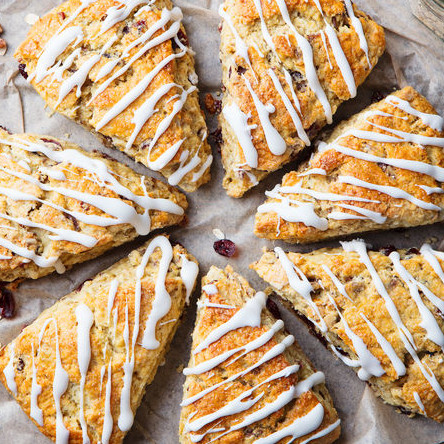
Scones
Also known as quick bread or American-style biscuits
What are Scones?
Scones are a type of quick bread made with chemically-leavened dough. Baking powder is the preferred leavening agent, and they are usually enriched with eggs, milk, dairy fat and sugar. Inclusions such as fruit, nuts or chocolate are often included.
Critical aspects in the production of scones include:
- Proper baking powder formulation
- Minimal to medium gluten development
- Rich formulations to obtain maximum flakiness and tenderness in the finished product
Origin
The term “quick bread” encompasses a wide range of non-yeasted products such as muffins, scones, biscuits, and coffee cakes. Quick breads are leavened by baking powders added to the formula and steam produced during baking.
History agrees that the first scones originated in Scotland, taking their name from the Stone of Destiny (or Scone), the place where Scottish kings were once crowned. Scone shapes are as diverse as their flavor and inclusion combinations, from the sweet to the savory types.1
How scones are made
Typical formulation for a savory butter scone:
| Ingredient | Baker’s % (based on flour weight) |
| Bread flour (patent flour from hard wheat)* | 100.0 |
| Baking powder | 5.0–6.0 |
| Salt | 0.8–1.5 |
| Butter (cold) | 20.0–30.0 |
| Cream* | 30.0–40.0 |
| Honey | 15.0–20.0 |
| Whole liquid eggs | 10.0–15.0 |
Processing
- Ingredients scaling
- Mixing
- Liquid and solids must be combined and mixed independently.
- Butter must be put aside and reserved for mixing with flour and rest of solids.
- For proper dough development and flour hydration, dairy cream, eggs, honey and butter should all contribute with at least 45% water absorption of dough.
- Cut the butter into the dry ingredients until it is the size of peas to obtain a short flake (small spatial areas in the crumb for a flaky-textured product).
- Add the liquid ingredients to the solids/butter flake and mix to incorporation and until the dough comes together (or becomes cohesive). Gluten development during mixing is not desired in scones production since it produces a tough texture in the finished product.
- Forming or makeup
- Roll the freshly mixed dough about 1 inch thick and use a 2.5″ cutter to cut dough circles. Dough scraps can be re-rolled for maximum yield.
- Place the scones onto a parchment or silicone mat lined baking sheet and brush the tops with the reserved egg wash.
- Blast freezing and packaging (optional for frozen scone dough)
- Egg washing (optional): Brush the tops of the dough with tan egg wash.
- Baking: Baking temperatures are typically 190°C (375°F), with a bake time of 15–17 minutes. Bake the scones until about tripled in height, and golden brown on the tops and bottoms.
Application
Refrigerated or frozen scones are found in virtually every US grocery store. The quality of cold-stored scone dough greatly depends on the stability of chemical raising agents. Once the raising agents come into contact with water, the chemical reaction to produce CO2 gas begins. In the production of frozen/refrigerated scone doughs, some of this raising capacity is usually lost due to premature reactions, leading to a loss of volume in the baked product. To avoid loss of product aeration and oven spring during baking, a change to a slower acting acid, such as SAPP or SALP, will be very useful.2,3
Refrigerated scones are more challenging than frozen scones. At freezing temperatures, most chemical reactions are virtually stopped due to the extremely low energy in the system. For higher temperature tolerance, some refrigerated scone doughs have been formulated with encapsulation technology. In this case, either the sodium bicarbonate or the baking acid, can be encapsulated inside a solid fat matrix. The fat capsule delays the production of most of the CO2 gas until the product enters the oven and the fat melts.2,3
References
- Suas, M. “Quick Breads.” Advanced Bread and Pastry: A Professional Approach, Delmar, Cengage Learning, 2009, p. 468.
- Cauvain, S.P. “Other Bakery Products.” Baking Problems Solved, 2nd edition, Woodhead Publishing, Elsevier Ltd., 2017, pp. 383–391.
- Wrigley, C., Corke, H., Seetharaman, K., and Faubion, J. Encyclopedia of Food Grains, 2nd edition, Volume 3 Grain-Based Products and their Processing, Academic Press, Elsevier Ltd., 2016, pp. 354–366.

